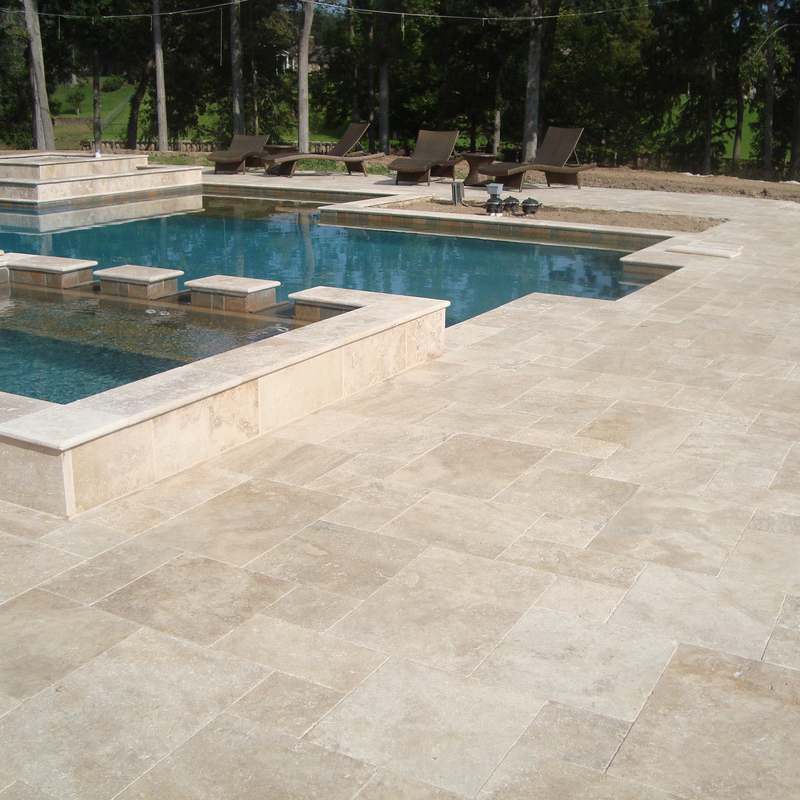In this article, we will explore the Roman or French style in the application of natural stone and marble for external facades or internal and external flooring. You may hear from engineers, contractors, or architectural designers about the “Roman style” or the “French/Versailles style” for installing stone, marble, and ceramics.
So, what is the Roman or French (Versailles) style in marble and natural stone installation?
It is a traditional pattern that dates back to ancient times. This style is characterized by installing tiles in various square or rectangular sizes, arranged in an interlocking pattern that appears random but, upon closer inspection, is harmonious and infinite.
The pattern for installing marble and natural stone in the Roman or French style is also known as the “Versailles pattern.” This style was first used in ancient Rome, where it was employed in the construction of baths, churches, houses, and castles. Later, it was adopted by the royal entities that ruled ancient France because they considered themselves as gods, designing their palaces and churches in the ancient Roman style to reflect that sacred aspect in their view.
One of the most famous palaces where this style was used for marble and natural stone installation is the Palace of Versailles, built in the 17th century. Due to its use, this pattern later became known as the “Versailles pattern.”
The Roman or French method of installing marble and natural stone consists of small tiles of four different sizes, harmonized in terms of dimensions (1/2 and 1/3), and consistent in thickness.
This style of tile and stone has always been popular in Europe and throughout the Mediterranean region, where limestone, marble, or granite was mainly used for floors and walls.
Popular Dimensions of the Roman or French (Versailles) Style in Marble and Natural Stone Installation:
The Roman style is installed in various thicknesses, with the most popular being 3 cm or 1.2 cm.
This translation provides a comprehensive overview of the Roman or French (Versailles) style for installing marble and natural stone, maintaining the essence and details of the original Arabic text.
First style:
8x8cm – 8x16cm – 16x16cm – 16x24cm
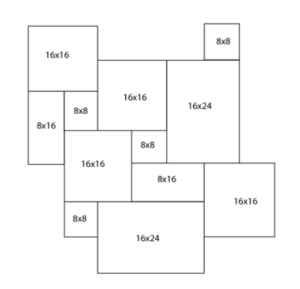
second style:
30.6×30.6cm – 15.3×15.3cm – 15.3×30.6cm – 30.6x46cm
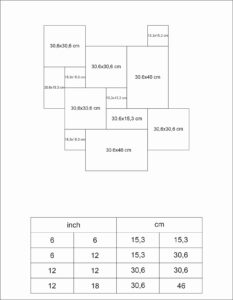
Third style:
20.3×20.3cm – 2.3×40.6cm – 40.6×40.6cm – 40.6x61cm
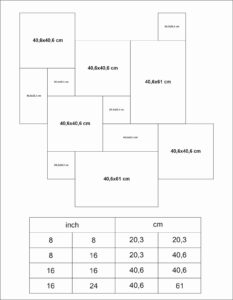
In these patterns, tiles made from any material can be used, but the most commonly used are those made from natural stone marble. Tiles made from porcelain and ceramic can also be used. Later, tiles cast from industrial materials like cement became popular.
The Roman or French pattern can be used in a variety of applications, including floors, walls, and surfaces. This pattern is an excellent choice for both interior and exterior designs.
Famous Types of Marble and Natural Stone Used in the Roman or French (Versailles) Pattern:
Any type of Turkish marble can be used in the Roman or French (Versailles) pattern, but the most famous types of Turkish marble used are Turkish travertine in all its colors:
- Silver Gray Travertine
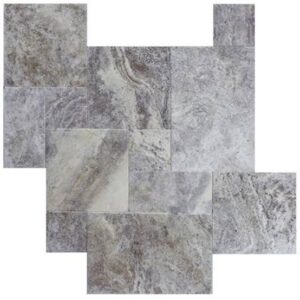
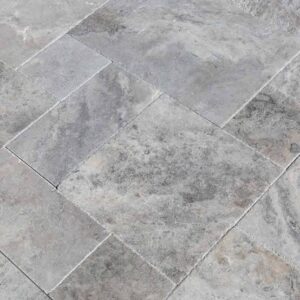
- Light Beige Travertine


- Dark Ivory Travertine

Advantages of the Roman or French (Versailles) Pattern in Marble and Natural Stone Installation:
The Roman or French (Versailles) pattern in marble and natural stone installation has many advantages, including:
- Unique Aesthetics: This pattern is known for its unique beauty. It creates an elegant, sophisticated, and infinitely harmonious look.
- Versatility: It can be used in a variety of applications, making it a great choice for both interior and exterior designs.
- Durability: The interlocking and cohesive nature of this pattern with different sizes makes it highly durable. It can withstand frequent and long-term use.
- Multiple Great Options:
Disadvantages of the Roman or French (Versailles) Pattern in Marble and Natural Stone Installation:
The Roman or French (Versailles) pattern comes with a set of disadvantages, which might not be considered as such by those seeking uniqueness and beauty:
- Cost: This pattern can be relatively expensive. Using varied tile sizes and colors can increase manufacturing and installation costs.
- Installation: Installing this pattern can be difficult. It requires precision and great care to create the correct pattern. Additionally, it may involve using specific adhesives and sometimes leveling the surface to be installed, increasing the cost.
- Size Calibration: During manufacturing, different sizes and angles must be precisely calibrated to ensure no discrepancies, allowing for harmonious installation.
Tips for Installing Marble and Natural Stone Using the Roman or French (Versailles) Pattern:
Here are some tips for installing marble and natural stone using the Roman or French (Versailles) pattern:
- Use High-Quality Tiles: Using high-quality tiles will create a more durable, beautiful, and harmonious pattern.
- Use a Level to Ensure Proper Alignment: Using a level will help you create an even and tight pattern.
- Use the Right Tile Installation Tools: The right tools will help you install the tiles correctly.
- Use High-Quality Adhesives or Construction Materials: For wall tiles, use high-quality adhesives. For flooring, use high-quality construction materials.
- Uniform Colors: Using uniform and harmonious colors is good in applications of marble and natural stone using the Roman or French (Versailles) pattern. However, some people prefer a variety of colors in a single application; this depends on individual taste.
- Work with Credible Supply Companies: Partner with highly credible companies experienced in manufacturing and supplying such stone patterns.
Kurabi Turkish Marble Company plays a significant role and has extensive experience in manufacturing, supplying, and installing marble and natural stone using the Roman or French (Versailles) pattern. Contact us for comprehensive consultation.

